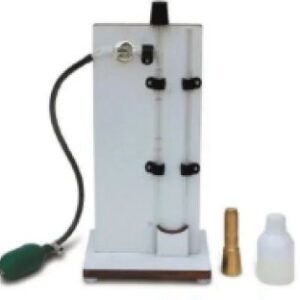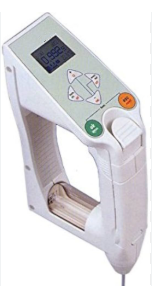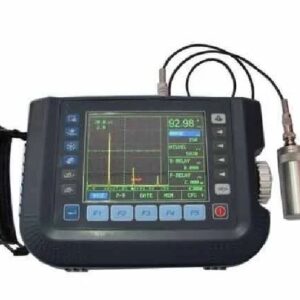REFRIGERATED CENTRIFUGE
MAKE DINESH SCIENTIFIC
DESCRIPTION:
With the use of centrifugal force, materials with varying densities can be separated in a sophisticated laboratory device called a chilled centrifuge. It works on the idea that the denser particles in a sample travel outward and form different layers when it is spun rapidly. The following is a thorough explanation of a chilled centrifuge: A sophisticated laboratory tool called a chilled centrifuge is used to separate particles according to their density from a liquid mixture. Centrifugal force is utilized by this apparatus to quickly spin samples in a temperature-controlled setting, usually between sub-ambient and room temperature.
FEATURES:
- Benchtop Refrigerated Centrifuge:
- Robust C.R.C. structure with powder-coated finish
- A centrifugal bowl made of stainless steel for added protection and simple cleaning.
- Equipped with an electronic drive and a well-balanced brushless motor.
- 20 characters in 4 lines. LCD display for rpm, CF, set and run times, and set times
- There is an automated dynamic brake and an imbalance detector.
MAIN COMPONENTS:
- ROTOR: The sample tubes or containers are held in place by the centrifuge’s rotor. It creates centrifugal force by spinning quickly.
- MOTOR: The rotor is driven by a strong motor, which enables high rotation rates
CONTROL PANEL: Users can adjust centrifuge process parameters like speed, temperature, and duration via the control panel.
REFRIGERATION SYSTEM:
- This feature separates a conventional centrifuge from a chilled one. It has a cooling system that keeps the centrifugation temperature low, which is essential for protecting the integrity of samples that are sensitive to temperature changes.
FUNCTIONALITY:
- CENTRIFUGATION: The main purpose is to rotate the samples quickly such that the denser components settle to the bottom of the tubes.
- REFRIGERATION: The centrifuge’s internal temperature is regulated by an integrated refrigeration system, which permits sample separation without jeopardizing the integrity of materials that are sensitive to temperature changes.
APPLICATIONS:
- CELL SEPARATION: Cells are divided according to density in biological research.
- PROTEIN PURIFICATION: vital for separating and purifying proteins from complicated mixtures in biological investigations.
- DNA AND RNA EXTRACTION: helps to separate nucleic acids from biological materials more easily.
- CLINICAL DIAGNOSTICS: utilized in clinical labs for a range of diagnostic procedures, including the separation of blood components.
TEMPERATURE CONTROL:
- Depending on the model, the refrigeration system can normally regulate the temperature between below ambient and below zero.
SAFETY FEATURES:
- LID LOCKING MECHANISM: Makes sure the centrifuge lid stays firmly closed while it is in use.
- AUTOMATIC IMBALANCE DETECTION: In the event of an imbalance, stops the centrifuge to protect the samples and the device.
CAPACITY AND SPEED:
- SAMPLE CAPACITY: To handle a variety of sample sizes and kinds, refrigerated centrifuges are available in a range of sizes and rotor designs.
- SPEED CONTROL: Users can adjust the centrifugation settings for various applications using variable speed control.
USER INTERFACE:
- Digital Display: For convenient monitoring of the settings, remaining time, and speed, the control panel usually has a digital display. In conclusion, a refrigerated centrifuge is a multipurpose laboratory instrument that combines temperature control and centrifugation principles, allowing scientists to precisely separate and analyze samples, particularly when working with materials that are sensitive to temperature.
TECHNICAL DETAILS:
| MODEL | DS-RC-SR |
| Purpose | To centrifuge various sample types at ambient temperature in various testing and research laboratories |
| RPM with no load | 15,000 – 18,000 rpm |
| Temperature of refrigerator in degree Celsius | -20°C |
| Weight including Rotor in kgs | 85 |
| Centrifuge design | Bench Top |
| “Number of steps of RPM Variation available in the settings (correspondingly RCF also varies)” | 100 |
| RPM setting accuracy | plus, minus 5% |
| Temperature control accuracy | ± 2°C |
| Accessories | instruction manual book |
| Type of lid lock | Electronically locked lids that automatically open at the end of the run |
| Ambient operating Temperature range in Degree centigrade Celsius and humidity range | 0 to 50 and Relative humidity 15 to 90% |
| Cooling arrangement | Compressor Cooling |
| No of acceleration and deceleration profiles in built for rotor speed while automatic braking | “Programmable from 50 to 200 Seconds in Interval of 5 Seconds” |
| timer set point | 60 minutes |
| Refrigerant CFC free | Yes |
| Display Type | LCD |
| Speed controller | Preprogrammed speed controller with microprocessor control that regulates both RPM and RCF |
| Speed Control tolerance in case of set speed (Plus minus RPM) in percentage | 20 |
| Configuration of Rotor supplied with centrifuge machine | Angle rotor |
| Rotor Feature with reference to Autoclavability | Autoclavable Rotor @121 Degree Celsius |
| Type of Tubes which used with centrifuge machine | Centrifuge tubes made of polypropylene and glass |
| Size of rotor supplied with centrifuge in ml | “12x2ml (for angle rotor) RPM 20000”,30x2ml, 15200 rpm |
| RCF | 12096 |
| Power supply | 220 Volts 50 Hz AC ± 10% |
| Power consumption in watts | 3000 |
| Length of the Centrifuge in mm | 680 |
| Width of the Centrifuge in mm | 520 |
| Height of of the Centrifuge in mm | 370 |
| Length of Power cord in meters | 1 |
| Temperature controller | Temperature control from +40°C to -20°C using an LCD-displayed PID digital temperature controller/indicator powered by a microprocessor |
| Type of Motor | Brushless (without carbons) |
| Parameters displayed by the digital display | Rotor running indicator, RPM, RCF, set time, run time, and any necessary balancing |
| Rotor imbalance diagnostics and automatic stop if required | Yes |
| Assembly Material for manufacture of Centrifuge | Rubber, plastic, stainless steel, CRC steel, die-cast aluminum, and aluminum sheet |
| Centrifuge Bowl material in Centrifuge | PUF insulation double walls to prevent cooling loss. Inner Chamber Moulded from 304 Grade Stainless Steel |
| Material of Rotor | Aluminium |
| Body material of Centrifuge | The stove painting or powder coating of C.R.C. steel finish. |
| Front Panel of centrifuge | CRC Steel finish with powder coating or stove painting or ABS Plastic of injection moulding |
| “Lid Material of Centrifuge” | Powder coating, stove painting, or injection molding ABS plastic are used to finish CRC steel. |
| Auto cut off | Yes |
| Condensed Water Drainage System | Yes |
| Servo stabilizer ratings in KVA | 2 |
| Servo Controller Voltage Stabilizer supplied with Item | Yes |
| Timer provided | Yes |
| ADDITIONAL | |
| Speed Range (xg) | 23,500 – 30,130 xg |
| Short Spin Key | Yes, possesses a separate short spin key |
| Speed Setting | Both rpm and rcf (relative centrifugal force) are feasible. |
| Temperature Range | -20°C to +40°C |
| Acceleration/Deceleration Control | Use of a dedicated key allows for gentle acceleration and deceleration. |
| Automatic Rotor Recognition | The device uses automatic rotor recognition to identify and adjust speeds when the rotor changes. |
| Tube Capacity | Able to accommodate 30 – 48 tubes (1.5/2 ml) |
| Temperature Stability | Able to maintain 4°C at speed |
| Fast Pre-Cooling Function | It is feasible to quickly pre-cool utilizing a specific Fast Temperature function. |
| Noise Level | 60 dB |
| Program Storage | Able to store 45 programs with quick access program keys |
| Rotor Lid System | Quick Lock-system for secure lid closing and opening |
| Rotor Flexibility | Able to accept rotors for a range of tube sizes, including spin column tubes and 0.2 ml PCR tubes. |












Reviews
There are no reviews yet.